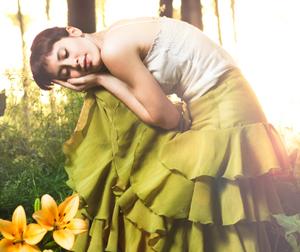Spanish-turned American Flamenco artist releases album inspired by colors of spring
Lara Bello released here new Flamenco album “Primero Amarillo, Después Malva” — “First Yellow, Then Purple.” (Photo courtesy of larabello.com.)
Lara Bello grew up surrounded by Flamenco music and dance.
Granada is one of the cradles of this emblematic Spanish tradition. As a teenager, Bello studied voice and violin at a conservatory. But before that, she learned how to sing and dance Flamenco.
“Before I started as a musician, I was a dancer,” Bello said. “I love very much to connect the sounds with the movements of the body. So I trained in Flamenco and contemporary dance and Arabic dance because the Arabic culture there is very strong.”
Bello’s new album is called “Primero Amarillo, Después Malva” — “First Yellow, Then Purple.”
She says the title refers to the changing colors of springtime in Granada.
“The beginning of the springtime, the flowers are yellow, and with time, those flowers die and then purple ones appear in their place,” Bello said. “So that’s why I dedicated that title to the cycles of life.”
Bello says she used to see these colors on the road from her house to her Flamenco teacher’s studio.
Bello’s Flamenco dance teacher was an American woman nicknamed La Presy. She moved from San Antonio to Granada about 30 years ago to learn Flamenco.
“And that means she came into a very, very strong community, very closed,” Bello said. “It’s not easy, even for people that are from Granada, which is a city where we all know a little bit about Flamenco, even people that don’t play or are not musicians or dancers, they know about Flamenco. And it’s difficult for us, so imagine for somebody who is from the other side of the ocean.”
La Presy became a well-respected figure in the Flamenco world. She died in 2011, but Bello says she continues to be an important influence in her career. In fact, she dedicated her album to La Presy.
“For all of us, all the students, she gave us a lot of power and also she taught us that your home is where the heart is,” Bello said. “It’s not a question about where you were born, or where you belong or the name of the city on your passport. It’s where your heart is.”
Bello moved to New York 2.5 years ago, where she found a new home in the diverse community of musicians from Latin America.
“When I was living in Spain, I didn’t know anything about Peruvian rhythms,” she said. “I started to work with them. I met great, not only musicians, but composers like Samuel Torres. And with two years in the city I wanted to put these strong roots into my music.
“And that’s how this CD has a little bit of rhythms and colors from Latin America, but also from New York.”
